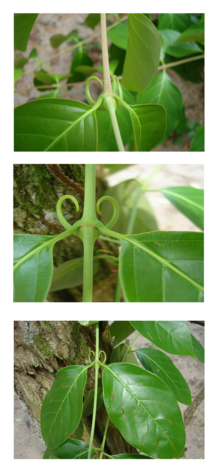Uncaria tomentosa
| Uncaria tomentosa | |
|---|---|

| |
| Scientific classification | |
| Kingdom: | Plantae |
| Clade: | Tracheophytes |
| Clade: | Angiosperms |
| Clade: | Eudicots |
| Clade: | Asterids |
| Order: | Gentianales |
| Family: | Rubiaceae |
| Genus: | Uncaria |
| Species: | U. tomentosa
|
| Binomial name | |
| Uncaria tomentosa | |
Uncaria tomentosa is a woody vine found in the tropical jungles of South and Central America. It is known as cat's claw or uña de gato in Spanish because of its claw-shaped thorns.[1][2] The plant root bark is used in herbalism for a variety of ailments, and is sold as a dietary supplement.[2][3][4]
Description[]
Uncaria tomentosa is a liana deriving its name from hook-like thorns that resemble the claws of a cat.[2][4] U. tomentosa can grow to a length of up to 30 m (100 ft), climbing by means of these thorns.[1] The leaves are elliptic with a smooth edge, and grow in opposing pairs. Cat's claw is indigenous to the Amazon rainforest, with its habitat being restricted primarily to the tropical areas of South and Central America.[1]
Taxonomy[]
There are two species of cat's claw commonly used in North America and Europe, Uncaria tomentosa and Uncaria guianensis, having different properties and uses.[4] The two are frequently confused but U. tomentosa is the more commonly used in traditional medicine.[5][6] U. tomentosa is further divided into two chemotypes that remain under preliminary research for their properties and compounds.[7] There are other plants which are known as cat's claw (or uña de gato) in Mexico and Latin America; however, they are entirely different plant species, belonging to neither the genus Uncaria, nor to the family Rubiaceae.[4][6]
Phytochemicals[]
Phytochemicals in Uncaria tomentosa root bark include oxindole and indole alkaloids, glycosides, organic acids, proanthocyanidins, sterols, and triterpenes, glycosides, tannins, polyphenols, catechins, and beta-sitosterol.[3][6][8] It also contains rhynchophylline.
Traditional medicine[]
Cat's claw has been used as a traditional medicine in South American countries over centuries for its supposed health benefits, and is a common herbal supplement.[2][4][6] The part used medicinally is the bark of the vine or root.[2] As of 2015, there is no high-quality clinical evidence that it has any benefit in treating diseases.[3][6]
Adverse reactions[]
Individuals allergic to plants in the family Rubiaceae and different species of Uncaria may be more likely to have adverse reactions to cat's claw.[4][6] Reactions can include itching, rash and allergic inflammation of the kidneys. People requiring anticoagulant therapy should not use cat's claw.[2][6] Phytochemicals in cat’s claw may inhibit the liver enzyme, CYP3A4, which oxidizes organic compounds, and may interfere with the intended effect of prescription drugs.[8]
See also[]
- List of ineffective cancer treatments
References[]
- ^ a b c d "Uncaria tomentosa". Germplasm Resources Information Network (GRIN). Agricultural Research Service (ARS), United States Department of Agriculture (USDA). Retrieved 2008-03-01.
- ^ a b c d e f "Cat's claw". Drugs.com. 7 June 2018. Retrieved 11 January 2019.
- ^ a b c "Assessment report on Uncaria tomentosa (Willd. ex Schult.) DC., cortex" (PDF). European Medicines Agency. 10 March 2015. Retrieved 11 January 2019.
- ^ a b c d e f "Cat's claw: Uncaria tomentosa (Willd.) DC.; Uncaria guianensis (Aubl.) Gmel". American Botanical Council. 30 January 2018. Retrieved 11 January 2019.
- ^ Gattuso M, di Sapio O, Gattuso S, Pereyra LE (2004). "Morphoanatomical Studies of Uncaria tomentosa and Uncaria guianensis Bark and Leaves". Phytomedicine. 11 (2–3): 213–223. doi:10.1078/0944-7113-00315. PMID 15070175.
- ^ a b c d e f g "Detailed Scientific Review of Cat's Claw (archived)". M.D. Anderson Center. 31 May 2006. Archived from the original on 26 August 2013. Retrieved 10 January 2019.
- ^ Keplinger K, Laus G, Wurm M, Dierich MP, Teppner H (1999). "Uncaria tomentosa (Willd.) DC. — Ethnomedicinal Use and New Pharmacological, Toxicological and Botanical Results" (PDF). Journal of Ethnopharmacology. 64 (1): 23–34. doi:10.1016/S0378-8741(98)00096-8. PMID 10075119.
- ^ a b "Cat's claw: Clinical and research information on drug-induced liver injury". LiverTox, US National Institute of Diabetes and Digestive and Kidney Diseases. 18 February 2019.
External links[]
 Media related to Uncaria tomentosa at Wikimedia Commons
Media related to Uncaria tomentosa at Wikimedia Commons- Uncaria tomentosa List of Chemicals (Dr. Duke's Databases)
- Uncaria
- Flora of Central America
- Flora of Trinidad and Tobago
- Flora of French Guiana
- Flora of Guyana
- Flora of Suriname
- Flora of Venezuela
- Flora of Colombia
- Flora of Ecuador
- Flora of Peru
- Medicinal plants